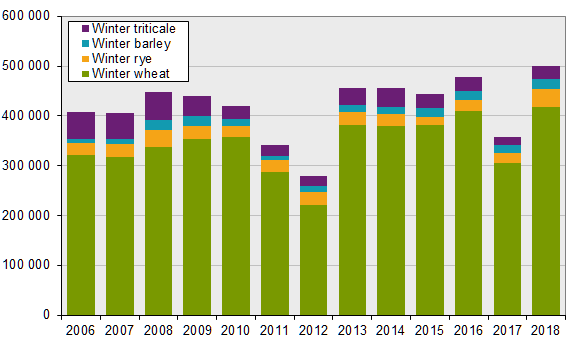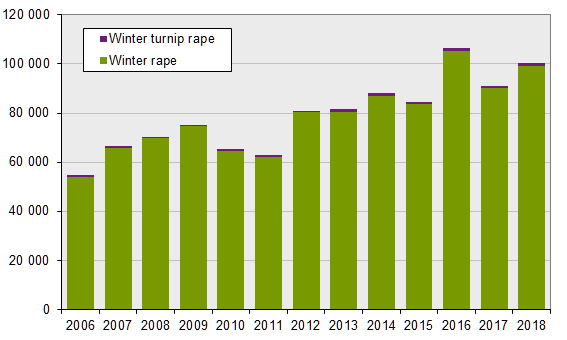Autumn sown areas 2018:
Large autumn sown areas
Statistical news from Statistics Sweden and Swedish Board of Agriculture 2018-11-30 9.30
Summer drought led to an early harvest of this year’s crops. This allowed time for many farmers to prepare the ground for autumn sowing, which was made use of to a great extent. This year’s autumn sowing of cereals and oilseed crops amounted to 601 300 hectares. This is 34 percent more than last year’s acreage and 14 percent more than the average of the past five years.
Autumn sown areas increased considerably in all parts of the country, especially compared with the previous year, when a rainy autumn often meant fields were not passable. In Halland County and Örebro County, areas increased by 64 percent and 52 percent respectively, compared with the previous autumn. In Västra Götaland County and Östergötaland County, autumn sown areas increased by 44 percent and 32 percent, respectively. In Skåne County, areas increased by 31 percent compared with the previous year. Large autumn sown areas are beneficial for many reasons, not least because they help reduce nutrition losses from arable land.
Winter wheat areas on par with the peak areas in 2016
This autumn, 418 600 hectares in total of winter wheat were sown in Sweden, which is similar in size to the peak areas in 2016. This year’s area is 37 percent larger than in the previous year and 13 percent larger than the average for the last five years.
Largest winter rye area since 2008
The autumn sown areas of rye amounted to 34 700 hectares, which is nearly 80 percent more than the previous autumn’s area, 62percent more than the five year average, and is the largest area since 2008.
Areas of winter barley and triticale on par with 2016 areas
Winter barley areas are estimated to 20 400 hectares, which is on par with the large areas in 2016, 24 percent more than areas in the previous year and 24 percent more than the five year average. Autumn sown areas of triticale are estimated at 27 500 hectares, which is on par with both the five year average and the 2016 areas. Compared with the previous year, there is a 76 percent increase.
Winter rape areas also on par with the peak areas in 2016
Winter rape areas are estimated to 98 900 hectares, which is 10 percent more than the previous year and on par with the peak areas in 2016. Winter rape areas are 11 percent larger than the five year average. Winter turnip rape areas are estimated at 1 200 hectares.
Organically cultivated autumn sowing also increased
The total autumn sown area that will be cultivated organically amounts to 50 200 hectares, which is 60 percent more than last autumn. There are 31 600 hectares of organically cultivated winter wheat area, which corresponds to a 76 percent increase compared with the previous year. Winter rape areas that will be cultivated organically amount to 5 900 hectares, which is 21 percent less than in the previous year.
Early sowing generated substantial stock
Many fields were sown early, and the prolonged warm autumn has meant that crops have had time to grow lush and dense. This increases the hazard of snow mould and other fungal diseases that could be detrimental for crop survival over the winter and might need to be resown in the spring. Some farmers have also reported wildlife damage to crops from wild boars and geese.


Note that the tables for cereals and oilseed crops use different scales.
Publication
A more detailed report of this survey and results by county and production area is published in the Statistical Report JO 18 SM 1801 and on the Swedish Board of Agriculture website.
The information is based on a survey where nearly 4 000 farmers submitted information to Statistics Sweden about autumn sown areas.
Feel free to use the facts from this statistical news but remember to state Source: Statistics Sweden.
